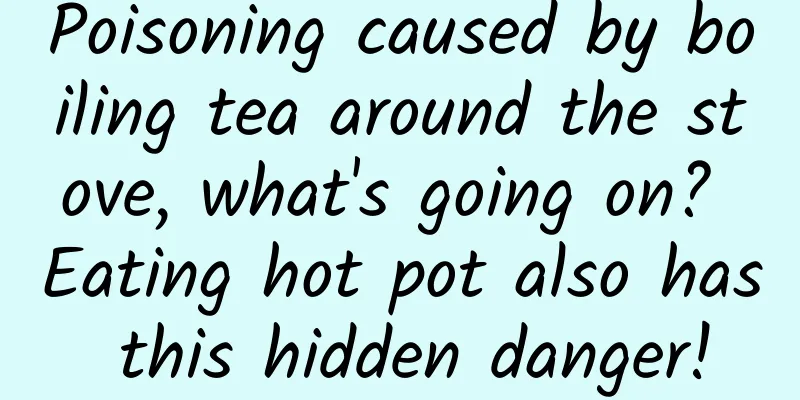Poisoning caused by boiling tea around the stove, what's going on? Eating hot pot also has this hidden danger!

|
On a cold winter day, people gather around a small charcoal stove, boil a pot of tea, and roast some marshmallows, oranges, nuts, sweet potatoes... The aroma of tea and fruit, warmth and comfort make you feel comfortable. The poetic act of "boiling tea around the stove" has become a "new favorite" for everyone to do when they get together. However, recently, there have been many cases of poisoning caused by "cooking tea around a stove". Young people closed the doors and windows at home, burned charcoal to cook tea, and a few hours later, they suffered from tinnitus, dizziness, nausea, confusion... and even life-threatening! This is because a large amount of carbon monoxide produced by the burning of charcoal quickly accumulates indoors, leading to carbon monoxide poisoning. Winter is cold, and carbon monoxide poisoning is more common. In addition to "cooking tea around the stove", eating hot pot and barbecue indoors, burning charcoal for heating, cooking with closed doors and windows, taking a bath, parking with closed windows and using air conditioning, etc., may all lead to carbon monoxide poisoning! Why does carbon monoxide poison people? Are there any sequelae after poisoning? How to save yourself and others in case of poisoning? How to prevent it in life? NetEase Health's "Health Open Class" has interviewed many experts on these issues. Let's review the relevant knowledge together! Why does carbon monoxide poison people? What are the symptoms and sequelae after poisoning? Why does carbon monoxide poison people? (Source: NetEase Health) Speaker: Zhao Li, Chief Physician of the Emergency Department, Fuxing Hospital Affiliated to Capital Medical University Carbon monoxide poisoning is poisoning caused by inhalation of the product of incomplete combustion of carbon-containing substances through the respiratory tract. Carbon monoxide easily combines with hemoglobin to form carboxyhemoglobin, which makes hemoglobin lose its oxygen-carrying capacity and function, causing tissue asphyxiation. It has toxic effects on tissue cells throughout the body, especially the cerebral cortex. Mild carbon monoxide poisoning may cause headache, dizziness, palpitations, nausea, vomiting, weakness in the limbs, and even brief fainting. Generally, the person remains conscious and the symptoms disappear quickly after inhaling fresh air and leaving the poisoned environment, and generally no sequelae are left. Moderate carbon monoxide poisoning may cause collapse or coma in addition to mild symptoms. The skin and mucous membranes will appear cherry red, a unique color of carbon monoxide poisoning. If rescued in time, the patient will quickly wake up and fully recover within a few days, generally without sequelae. Severe carbon monoxide poisoning patients present with deep coma, loss of all reflexes, incontinence, cold limbs, low blood pressure, rapid breathing, and will soon die. Generally, the longer the coma lasts, the worse the prognosis, often leaving sequelae such as dementia, memory and comprehension impairment, and limb paralysis. How to save yourself and others in case of carbon monoxide poisoning? Learn the life-saving knowledge now! How to save yourself or others after carbon monoxide poisoning? (Source: NetEase Health) Speaker: He Xinhua, Chief Physician of the Emergency Department, Beijing Chaoyang Hospital, Capital Medical University When using a coal stove, wood stove, or gas stove in a confined space, if you experience symptoms such as headache, dizziness, palpitations, nausea, vomiting, or weakness in the limbs, open the doors and windows as soon as possible and leave the scene. If you are too weak to stand, considering that carbon monoxide is lighter than air, you can crawl on the ground and escape as soon as possible. If you find someone suffering from carbon monoxide poisoning, you should pay attention to the following when rescuing them: 1. Rescuers should crawl into the scene; 2. Open doors and windows for ventilation, quickly move the patient to a ventilated and warm place and lay him/her flat, unbutton his/her collar and belt to facilitate breathing; 3. For unconscious patients, their heads can be tilted to one side to prevent vomitus from being accidentally inhaled into the lungs and causing suffocation; 4. For those whose heartbeat and breathing are weak or have stopped, perform cardiopulmonary resuscitation immediately; 5. At the same time, call an ambulance and send the poisoned person to a hospital with a hyperbaric oxygen chamber for emergency treatment. In case of other poisoning, you should first leave the poisoning environment, avoid further contact with the source of poisoning, and then expel the poison from the body as much as possible. If the situation is serious, be sure to call the emergency number in time and go to the hospital for targeted treatment and examination. How to prevent carbon monoxide poisoning? Don't think it has nothing to do with you! How to prevent gas poisoning? (Source: NetEase Health) Speaker: He Xinhua, Chief Physician of the Emergency Department, Beijing Chaoyang Hospital, Capital Medical University The main places where non-occupational carbon monoxide poisoning is prone to occur are homes, including rooms that use coal stoves, charcoal fires and other heating equipment, toilets or shower rooms with gas or coal gas water heaters, and kitchens that use gas or coal gas stoves. In addition, garages, basements and closed air-conditioned cars that use small oil or gas generators are also high-risk places for non-occupational carbon monoxide poisoning. The water heater or gas in the home should not be placed in the room where family members gather, and the gas water heater should not be installed in a closed bathroom or poorly ventilated area. When purchasing gas or coal gas water heaters, you must choose water heaters produced by regular manufacturers and of qualified quality; you must ask professionals to install them, and they can only be used after passing the inspection. Do not change the gas or coal gas pipeline facilities without permission. When using gas or coal gas water heaters, maintain good ventilation, avoid bathing for too long, and check whether the water heater is completely turned off after use. Regularly inspect and maintain the pressure reducing valves and hoses of gas and coal gas water heaters. If any problems such as damage, rust, or leakage are found, they should be replaced in time. When using gas or coal water heaters at home, it is best to install a carbon monoxide detector and conduct regular inspections and maintenance to ensure that the detector is functioning properly. When using gas in daily life, you should always keep the room well ventilated, especially in winter and rainy days; you should smell the gas before using a gas appliance to determine whether there is a leak; if an automatic gas appliance fails to ignite continuously, you should wait for a while to allow the leaking gas to dissipate before igniting it. Although it is pleasant to "drink tea around the stove", cook hot pot at home, and barbecue on a stove", the potential safety hazards should not be ignored. Remember to forward this article to your relatives and friends so that they can also understand these health knowledge that concerns life! |
<<: How long will it take to prepare for pregnancy after testing positive for COVID-19?
Recommend
PS4 "Gravity Rush: Remastered" review: conscientious remake of the controller function further demonstrated
After Tearaway: Unsealed was launched in China, t...
Hadrosaur fossils first discovered in southwest my country, was the Shu Road easy billions of years ago?
Author: Shi Xiangqi and Li Chuanfu In the long hi...
No. 1 in hot search, Zhong Xuegao responded!
Yesterday at noon, @钟薛高 issued a statement, Ranke...
Data | Big data explains whether Internet car manufacturing is reliable
The video maker is going to make cars, the home a...
Everything can be "hyaluronic acid"
The temperature dropped a while ago and I had a s...
Where did you buy your phone? Physical store or e-commerce platform, the two are very different
introduction Looking at the emerging fields in th...
How did "Your Name" achieve box office revenue of over 100 million yuan in a single day and gain both good reputation?
"Your Name." opened on December 2. Acco...
Android 12 upgrade: No user interaction is required to install third-party mall apps under the premise of safety
In response to pressure from Epic Game and govern...
WordPress personal website building tutorial, WordPress website building tutorial complete set of twelve sections [Directory]
This complete set of WordPress website building t...
The Bass of the Universe: The Ensemble of the Milky Way's Most Mysterious Objects
The artist's concept above shows stars, black...
It's time to defend the potato! We've been so misunderstood about it...
Compiled by: Gong Zixin Potatoes are high in star...
Data Brother Qianchuan practical online advanced course video
Data Brother Qianchuan practical online advanced ...
Zuckerberg was elected the best CEO in the US technology industry
On the morning of February 9, the 9th Crunchies A...
Yizhuo.com’s product removal phone number is unreachable: the money-burning model of fresh food e-commerce is difficult to sustain
During this period, Ms. Liu, a citizen, found tha...
How much does it cost to invest in the Hailar Furniture Mini Program?
How much does it cost to attract investors for th...









